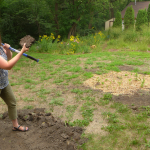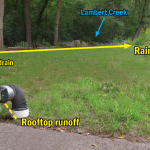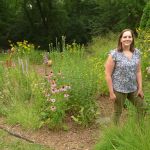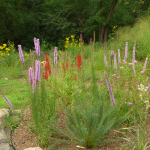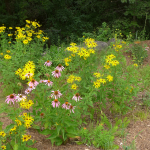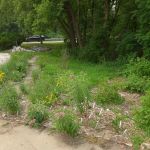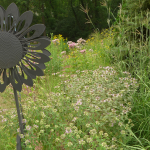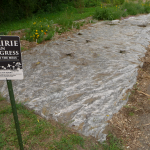Neighborhood Spotlight: Katherine Doll
Katherine started looking into a stormwater improvement plan in 2018. By adding to the effort piece-by-piece, the property now includes several raingardens, prairie and shade plantings, and some areas of lo-mow turf. Being situated up against Lambert Creek, these raingardens slow and retain runoff that used to rush down and erode the creek banks. The largest raingarden in the backyard has stormwater drain into it from multiple sources. The biggest source of stormwater comes from the roof gutter system, which empties into an elongated underdrain that extends across the backyard into the raingarden. This underdrain is perforated, so it infiltrates gradually into the soil as it goes, and what doesn’t infiltrate through the underdrain lands in the raingarden to infiltrate there.
But these efforts have included some surprises along the way. One example was discovering a backyard driveway that was covered with grass sod by the prior homeowners. The sod perished in the Summer, 2021 drought due to its very shallow root system being blocked by the driveway beneath it. Eventually Katherine hopes to remove the hidden driveway and replace it with a lo-mow turf. Such transformations are an ongoing effort tackled in doses, but the summer of 2021 was still a great time to visit Katherine’s projects and see the progress so far.
Raingarden Chat with Katherine:
Your property is in a unique setting in the way that it connects directly to Lambert Creek. Can you provide an overview of what challenges and assets you were working with when you got started?
There have been many challenges with this location, including a driveway hidden under turf in the backyard, water pooling near the house after rainfalls and water runoff coming in from the neighboring property. A couple of these challenges have been addressed with the addition of raingardens in the backyard, but more work is planned to improve stormwater management in the backyard and this remaining challenge will be addressed with future projects. Although the property has challenges, there are assets to the location. The proximity to the creek provided the initial inspiration to install raingardens to capture stormwater and protect our water resources. The creek attracts wildlife to the property because there’s a reliable nearby water source, and the addition of the raingardens has encouraged even more wildlife to the yard.
What motives did you have to create the raingardens and where did you get the idea?
The motivation initially was due to the observation of pooling water in the backyard near the house that did not drain quickly after a rainfall. Upon discovering the hidden driveway and compacted soil around the backside of the house, a solution was to install underdrains around the house that empty into a raingarden. A combination of a few raingardens in the backyard collectively work to capture stormwater that was previously running uncontrolled down the bank into the creek, eroding the bank and causing damage to both the property and creek.
What strategies or needs went into the design process?
There were several areas in the backyard nearby the house where water pooled following a rainfall, so multiple inlets into a French underdrain were installed underground which routed into a raingarden. Because the raingarden is sized only to handle a 1-1.5” rain event, overflows were designed to ensure water still moved away from the house in occasional larger rain events we experience in this region. In the front yard, a raingarden was installed to capture runoff from the driveway that had over years caused very deep and steep erosion on the slope to the creek. This raingarden has berms built up, planted with sedges and native flowers, and an overflow that directs into the lawn instead of down to the creek. The raingardens were all designed to capture the majority of rain in common rainfall events, but consideration was taken into where water will go when much larger ran events occur to minimize velocity and volume of stormwater reaching the creek.
What do you enjoy most about the raingardens?
Over the years the plants have matured and more insects and birds are visiting the raingardens. I enjoy watching the Monarch caterpillars and butterflies. There are also a couple hummingbirds that love to visit the Cardinal Flowers in the garden. Besides the wildlife, it is interesting to watch the raingardens on rainy days. It is amazing how much water they can hold, and how quickly the water infiltrates into the ground.
How has it changed your interaction with your yard?
As a child and teenager I was very frequently in the yard. My parent’s property was in a rural setting with two acres filled with various flower gardens, a vegetable garden, apple trees, and bird feeder. There was much to enjoy in that outdoor setting. When I first became a homeowner myself, I did not spend time outdoors in my yard. My relationship with my yard was to mow and then go inside. There wasn’t anything in my yard to attract wildlife nor to keep me interested in being in my yard. It wasn’t until this current house here in Vadnais Heights where this changed. My interaction with my yard first started as a drainage problem to solve. In my research to resolve the issue, I learned that I could direct it away from the house and forget it (i.e. to storm drain or creek), or I could build a raingarden that would serve multiple purposes: capture stormwater runoff, help support the watershed and downstream neighbors, provide beauty with native plantings, and provide for wildlife. I now spend most of my free time in the yard during the non-winter months because my raingardens and other native plantings lure me into the yard to see the wildlife. I like to observe new insect/plant interactions, or to figure out what were the turkeys eating this time? I now enjoy gardening for wildlife because I want to be a good steward of the land and water resources nearby. I am even in my yard more often in the winter because I am walking around planning what I would like to do next!
What’s the most challenging part of the raingarden?
The initial design and installation of a raingarden is the challenging part, but once that is completed, the maintenance is not any different than tending to any other intentional planting. Although designing a raingarden is challenging, it is also a very fun and engaged process because you become better aware of your yard’s features and how water moves across the yard in order to understand how to purposely modify to capture stormwater.
What has surprised you as you’ve maintained the project?
It becomes surprisingly easy to maintain after the first couple years have passed. The first couple years you have to be diligent about pulling unwanted plants and observing if your intended plants are thriving in their location. I have had to replace some plants as some spots were not optimal for them, but now that a few years have passed, everything is thriving and there is very minimal weeding. The majority of the weeding is along the walking paths as that area is the most disturbed and prone to unwanted volunteers. The majority of the garden needs very little weeding as the native plants fill in nicely and provide strong competition against any unwanted weed introductions.
What would you do differently if you could start it all again?
In regards to the raingardens, I wouldn’t change anything. However, something I would do differently is I would have dealt with the sod over the hidden driveway in my backyard sooner. With the drought we experienced in 2021, the sod over that driveway area all died off in the summer and was quickly replaced by a variety of opportunistic weeds that could thrive in a dry environment without competition from the turf grass. I could have saved the grass with copious amounts of water repeatedly throughout the summer, but I did not want to nurse a lawn along a drought, using copious amounts of water, when it’s not the right plant in the right place, particularly given the driveway material directly underneath it. Now in 2022, I will have to be vigilant in preventing those weeds from going to seed and creating additional volunteers in other places of the yard. I hope to be able to resolve this situation in Summer 2022 and I am still thinking about what I will replant the area with. I get to re-start that backyard and have the opportunity to put in something more resilient and beneficial to wildlife, so I can guarantee it will not be Kentucky bluegrass.

